How we prepared the network in Kazan for the Universiade congestion
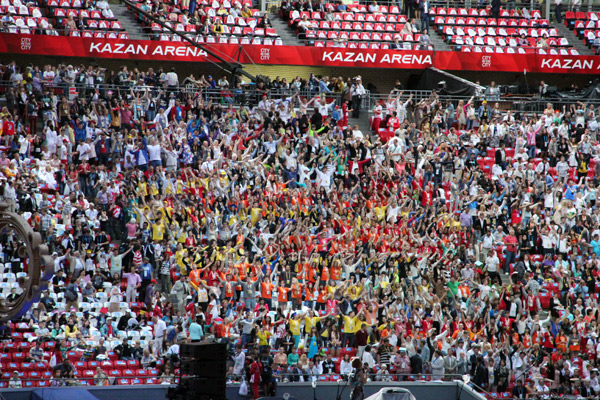
All these people needed cellular communication at the Universiade 2013 in Kazan
Major sporting events are always congestion for individual sections of the network where the largest number of subscribers is observed. This is not similar in profile to seasonal peaks, for example, to the New Year - there are as many subscribers in a cell as usual, they just all start calling at about the same time. In the case of the Universiade, the number of subscribers per cell in some places simply exhausted the channel capacity.
Preparation began in 2012. The backbone network was modernized (so that the channel emanating from the city would not become a bottleneck), the core of the mobile network; construction of new base stations was carried out; construction of new cable lines; work on the transport network.
')
Perhaps the most difficult was in just 5 working days to establish coverage at the newly opened metro stations.
Capacity and coating
The frequency resource allocated for each of the operators is limited. At the same time, the number of physical communication channels, respectively, is also limited. Therefore, in cellular communication the same frequency channels are used repeatedly, but in different territories, in different sectors. To provide coverage in the area of dense development, for example, megalopolises, the operator needs to use the same frequencies in closely located territories. This causes co-channel interference.
The closer the BS using the same frequencies - the higher the interference. At some point, the interference level does not allow building base stations closer to each other. When this is achieved, the maximum density of the coating. If you build a new base station in such a territory (or bring a mobile one), this will increase the signal level - but not the number of subscribers simultaneously talking. Physics can not be fooled: the channels will no longer be.
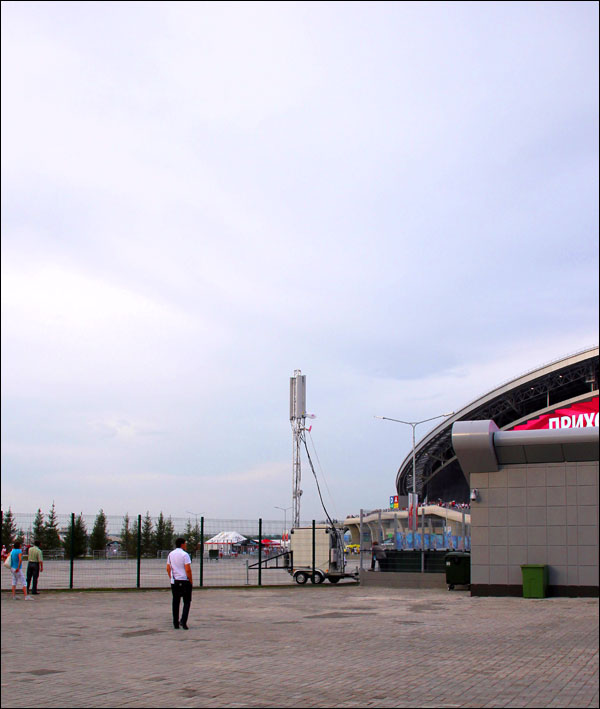
The base station near the stadium solves two tasks: it allows you not to mount an additional one (ensuring maximum capacity) and gives a good signal at the entrance. Chassis - van.
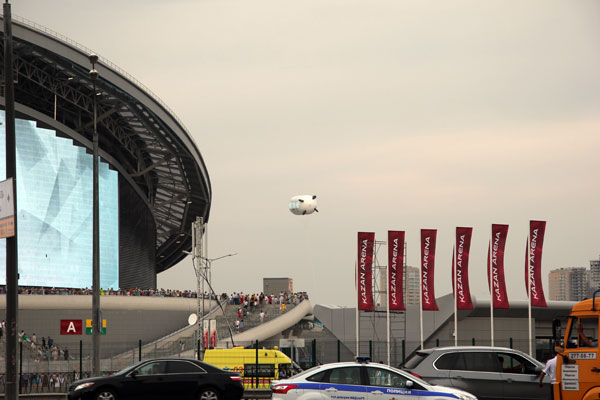
This is what a mobile BS looks like on the other hand - it is behind the yellow car.
In Kazan, it is possible to rest on such maximum coverage only where new base stations appeared - that is, near the Universiade facilities. In the sense that we are not a metropolis, and there was no maximum coverage density before. For the Universiade, we have upgraded our network so as to provide capacity close to the maximum.
We changed the old BSs to new ones somewhere entirely, somewhere only individual modules of distributed BSs, modernized the power supply and air conditioning systems. They implemented HSPA +, the second carriers on 3G, connected 3G BS with Ethernet / IP packet transport.
The planning department also calculated all possible points with increased load (for example, at railway stations, in residential areas, and so on) - we also modified base stations at them.
Highway
At the same time there is another limitation - the main channel. In our case, by the beginning of the Universiade, the trunk projects for the modernization of the FOLM “Large European Ring” were completed. On the basis of new and extended existing DWDM nx 40G channels, the following training was carried out on the IPBB network:
- New direct directions nx 10GE (Ufa - Moscow, Volgograd - Moscow, Samara - Moscow) were organized. Traffic from Ufa after that went straight to the DWDM channel to Moscow, without loading the Kazan-Moscow channel. Physically, Ufa-Moscow still passes through Kazan, but only with DWDM spectral channels, without passing through our routers.
- Added additional capacity to the existing Tula-Moscow and Nizhny Novgorod-Moscow directions;
- The traffic was redistributed, leading to a decrease in the overloaded Kazan-Moscow direction from 92% to 40%,
Underground
To ensure communication in the metro, a rather simple scheme with several antennas and taps on the feeder track is used. Planning such a route and the location of antennas depends on the layout of the premises. Antennas are located at various points in the station lobby to cover it as efficiently as possible. Special antennas are sent to the tunnels, but the availability of communication in the tunnels depends on their configuration. In straight lines, it can be on the whole stretch, but in sinuous signal there will be no after a couple of bends.
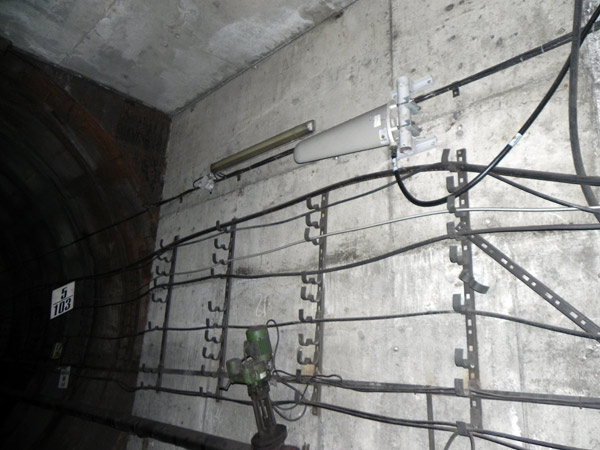
Antenna

Practically in any city where there is a subway, it is not easy to carry out work - they are allowed only after complicated agreements
BS preparation
Both for the construction of new BSs and for the deployment of mobile BSs, as usual, obtaining new permissions and frequencies is required. Fortunately, for a number of new facilities, we obtained temporary permits through an expedited procedure, so that we could work during the Universiade.
During the ceremonies, the engineers constantly monitored the situation and, with a serious increase in traffic, made changes in the BS settings to improve service depending on the traffic profile. Priority was given to voice traffic, that is, if the voice load grew, the resources of the base stations were redistributed so as to provide subscribers with the opportunity to talk. This was done almost on-line. I remind you that the usual consumption profile is about 5% of the main voice data traffic.
To support HSPA +, there are specific requirements for the BS equipment and the transport network transmitting traffic between the network core and the BS. Somewhere (mostly on new base stations) it was enough to just download a license, somewhere they did it right after upgrading the transport network and expanding channels, and in a considerable number of cases, it was necessary to install boards providing resources, replacing radio modules and so on. Different actions were required for different BSs, and there were a lot of them - we worked without interruption for several months before the Universiade.
At the same time, we have just finished the work on the transfer of the cable from the urban lighting poles to the sewer system. This was done in the following way: a new line or its new section was built, the places of pairing a new line with existing lines or nodes were determined, a switching plan was drawn up. If a new line is from node to node, then switching was quite simple and often could be done during the day (if there are backup channels for traffic); if the line section was changed, then welding of optical couplings was required, during which the fibers switched to a new section - such work was carried out only at night with the least load on the network to minimize the impact on service and customers.
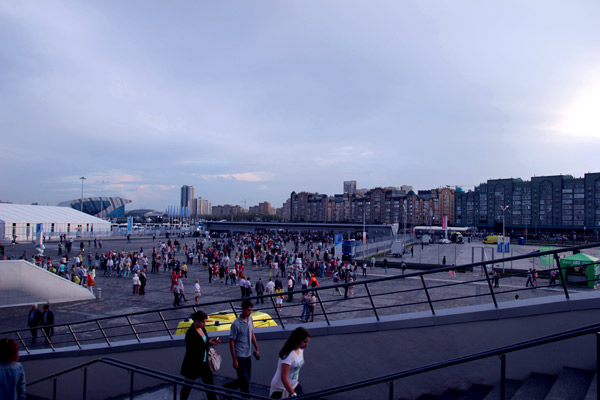
The entrance area, people much more than usual.
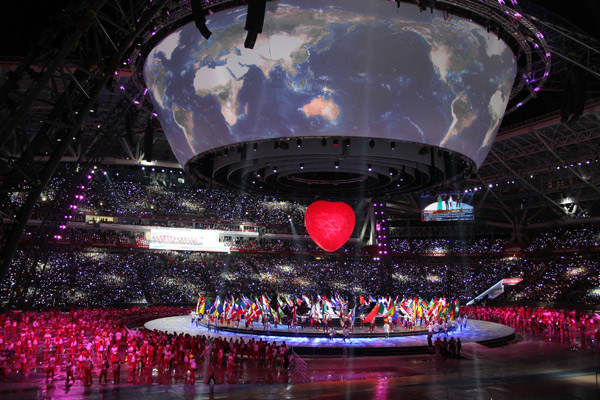

Peaks
The most revealing peak moments were the opening and closing ceremonies, as well as the Sabantuy feast, which brought together many people. As I said, we covered these objects with modified BSs, plus we used mobile base stations deployed in place.
About the turnstiles of the stadium, the mobile BS was used in the configuration 2G 900 MHz, 2G 1800 MHz, 3G. When deploying, neighbors were prescribed (to ensure a seamless transition to other neighboring BSs), frequencies were calculated for BS 2G, immediately after deployment, the planning and optimization engineer with test equipment checked the BS interference and operation of handover passes. The channel from the mobile BS was organized by radio (RRL), with a capacity of 200 Mbit / s.
Sabantuy was held not in the center, but in the Birch Grove near the village of Mirny. There are usually quite a few people there, so I just needed a mobile BS. It was used in the configuration 2G 900 MHz, 2G 1800 MHz, 3G. At the nearest BS, 2G transmitters were added to increase the capacity in the 2G network, 3G stations were transferred to transport via Ethernet, plus the second carrier frequencies were added.
After the Universiade
After Sabantui, the BS configuration was reduced to 2G, since in normal time there is no such load. Mobile BS were down.
For the rest, we did not change the network configuration in the direction of reduction, that is, in Kazan now there is enough reserve for the growth of the city for several years ahead and other such major events.
Source: https://habr.com/ru/post/193102/
All Articles